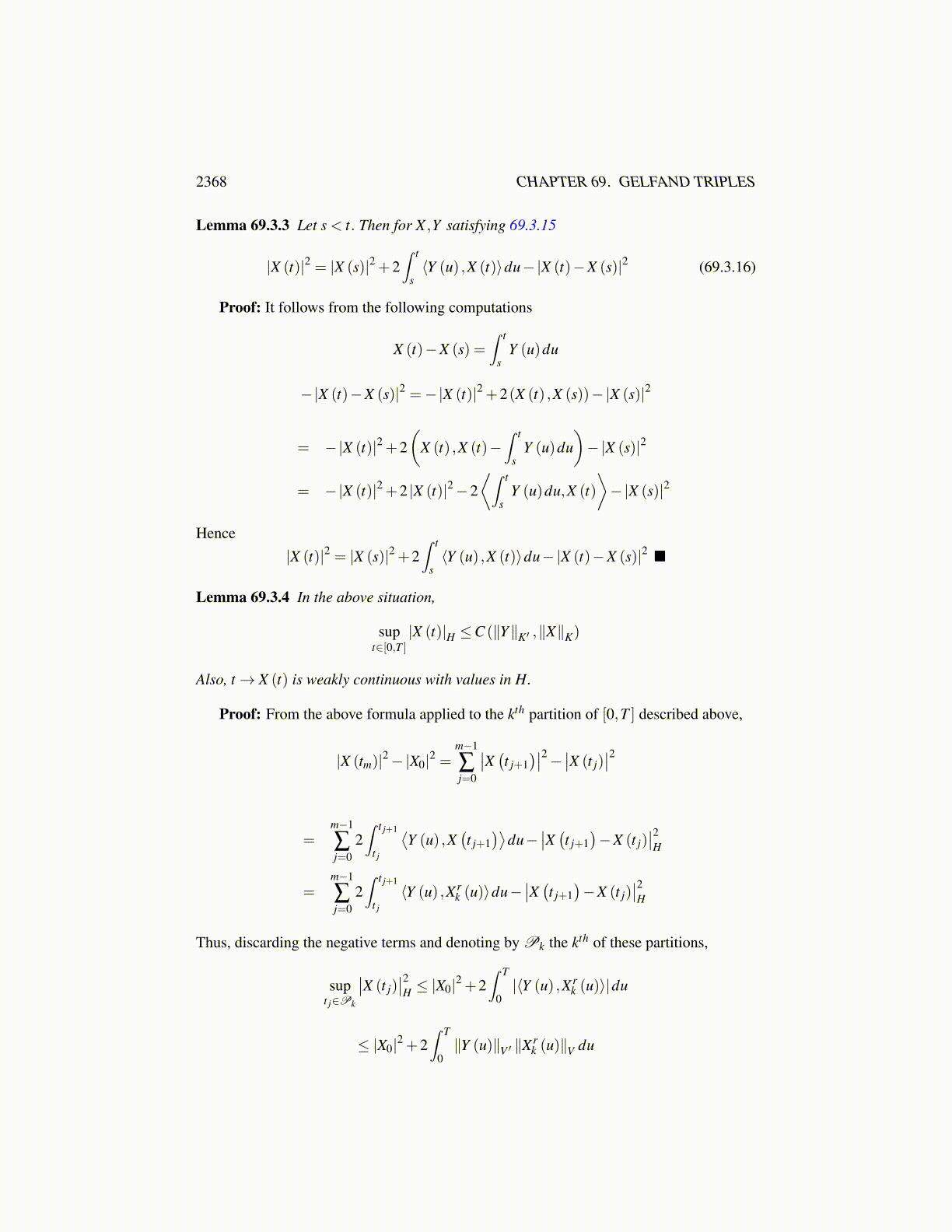
2368 CHAPTER 69. GELFAND TRIPLES
N be large enough that fn (−T ) = 0 for all n > N. Then for m,n > N and t ∈ [−T,2T ]
| fn (t)− fm (t)|2H = 2∫ t
−T
(f ′n (s)− f ′m (s) , fn (s)− fm (s)
)ds
= 2∫ t
−T
⟨f ′n (s)− f ′m (s) , fn (s)− fm (s)
⟩V ′,V ds
≤ 2∫R
∣∣∣∣ f ′n (s)− f ′m (s)∣∣∣∣
V ′ || fn (s)− fm (s)||V ds
≤ 2 || fn− fm||Lp′ (R;V ′) || fn− fm||Lp(R;V )
which shows from the above that { fn} is uniformly Cauchy on [−T,2T ] with values in H.Therefore, there exists g a continuous function defined on [−T,2T ] having values in H suchthat
limn→∞
max{| fn (t)−g(t)|H ; t ∈ [−T,2T ]}= 0.
However, g = f̂ a.e. because fn converges to f in Lp (0,T ;V ) . Therefore, taking a subse-quence, the convergence is a.e. It follows from the fact that V ⊆H = H ′ ⊆V ′ and Theorem69.2.9, there exists f (0) ∈V ′ such that for a.e. t,
f (t) = f (0)+∫ t
0f ′ (s)ds in V ′
Now g = f a.e. and g is continuous with values in H hence continuous with values in V ′andso
g(t) = f (0)+∫ t
0f ′ (s)ds in V ′
for all t. Since g is continuous with values in H it is continuous with values in V ′. Taking thelimit as t ↓ 0 in the above, g(a) = limt→0+ g(t) = f (0) , showing that f (0)∈H. Therefore,for a.e. t,
f (t) = f (0)+∫ t
0f ′ (s)ds in H,
∫ t
0f ′ (s)ds ∈ H.
Note that if f ∈ Lp (0,T ;V ) and f ′ ∈ Lp′ (0,T ;V ′) , then you can consider the initialvalue of f and it will be in H. What if you start with something in H? Is it an initialcondition for a function f ∈ Lp (0,T ;V ) such that f ′ ∈ Lp′ (0,T ;V ′)? This is worth thinkingabout. If it is not so, what is the space of initial values? How can you give this space anorm? What are its properties? It turns out that if V is a closed subspace of the Sobolevspace, W 1,p (Ω) which contains W 1,p
0 (Ω) for p≥ 2 and H = L2 (Ω) the answer to the abovequestion is yes. Not surprisingly, there are many generalizations of the above ideas.
69.3 An Important FormulaIt is not necessary to have p > 2 in order to do the sort of thing just described. Here is amajor result which will have a much more difficult stochastic version presented later. Firstis an approximation theorem of Doob. See Lemma 65.3.1.